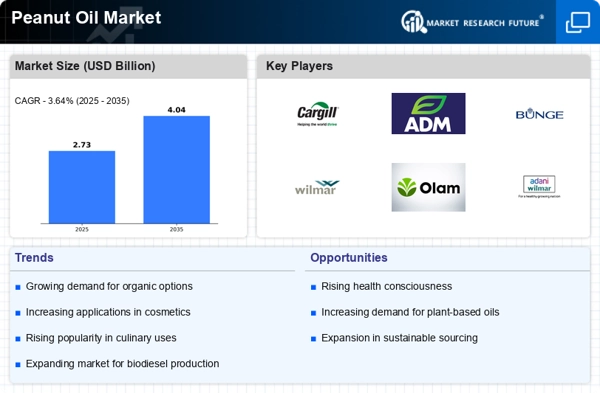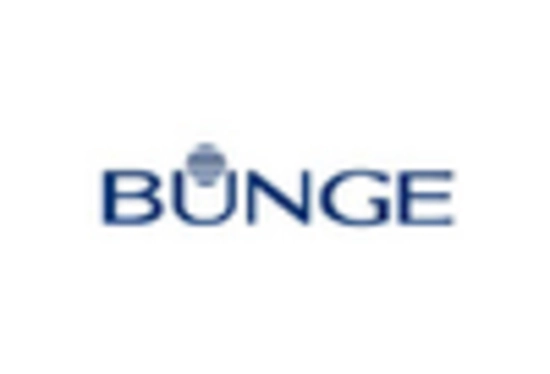Rising Health Awareness
The Peanut Oil Market is experiencing a notable surge in demand due to increasing health awareness among consumers. As individuals become more conscious of their dietary choices, the preference for healthier cooking oils has escalated. Peanut oil, known for its high monounsaturated fat content and favorable fatty acid profile, is perceived as a healthier alternative to saturated fats. According to recent data, the consumption of peanut oil has risen by approximately 15% over the past year, reflecting a shift towards oils that support heart health. This trend is likely to continue as more consumers seek oils that not only enhance flavor but also contribute positively to their overall well-being. The Peanut Oil Market is thus positioned to benefit from this growing health consciousness, potentially leading to increased market share and expansion opportunities.
Sustainable Agriculture Practices
The Peanut Oil Market is increasingly shaped by the adoption of sustainable agricultural practices. As consumers become more environmentally conscious, there is a rising demand for products that are produced through eco-friendly methods. Peanut oil, derived from peanuts that can be cultivated with lower pesticide use compared to other crops, is gaining traction among consumers who prioritize sustainability. Furthermore, initiatives aimed at promoting organic peanut farming are contributing to the growth of the Peanut Oil Market. Data suggests that the organic peanut oil segment has seen a growth rate of approximately 10% annually, reflecting a shift towards products that align with sustainable values. This trend not only supports environmental health but also appeals to a demographic that is willing to pay a premium for sustainably sourced products.
Culinary Innovation and Versatility
The Peanut Oil Market is significantly influenced by culinary innovation and the versatility of peanut oil in various cuisines. Renowned for its high smoke point and neutral flavor, peanut oil is favored by chefs and home cooks alike for frying, sautéing, and dressing. The oil's ability to enhance the taste of dishes without overpowering them makes it a staple in Asian and African cooking, where it is widely used. Recent market analysis indicates that the demand for peanut oil in food service establishments has increased by 20%, driven by the growing trend of diverse culinary experiences. As restaurants and food manufacturers continue to explore new recipes and cooking techniques, the Peanut Oil Market is likely to see sustained growth, catering to an expanding consumer base that values both flavor and quality.
Emerging Markets and Economic Growth
The Peanut Oil Market is poised for growth due to emerging markets and their economic development. As economies in various regions expand, there is an increasing demand for cooking oils, including peanut oil, driven by rising disposable incomes and changing dietary habits. Countries in Asia and Africa are particularly notable, where the consumption of peanut oil is projected to increase significantly. Market forecasts suggest that the demand for peanut oil in these regions could grow by 25% over the next five years, as more consumers adopt western dietary patterns that include fried and processed foods. This trend presents a substantial opportunity for the Peanut Oil Market to expand its reach and cater to a burgeoning consumer base eager for diverse cooking options.
Increased Use in Personal Care Products
The Peanut Oil Market is witnessing a growing trend in the use of peanut oil in personal care and cosmetic products. Known for its moisturizing properties and skin benefits, peanut oil is increasingly incorporated into lotions, creams, and hair care products. The oil's natural composition makes it an attractive ingredient for consumers seeking chemical-free alternatives. Recent market data indicates that the personal care segment utilizing peanut oil has expanded by approximately 12% over the last year, driven by the rising demand for natural and organic beauty products. As consumers continue to prioritize health and wellness in their personal care routines, the Peanut Oil Market is likely to experience further growth in this sector, presenting new opportunities for manufacturers and marketers.


















Leave a Comment